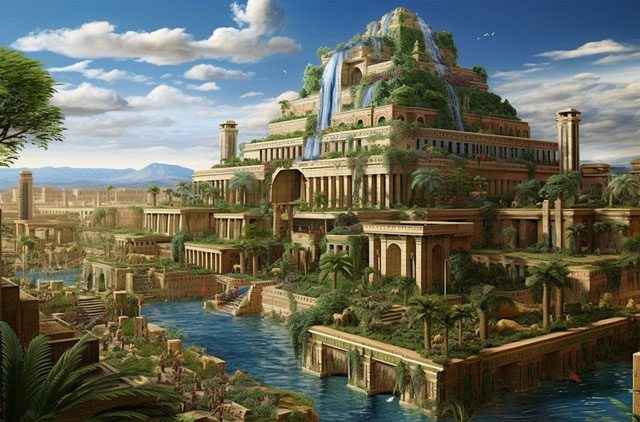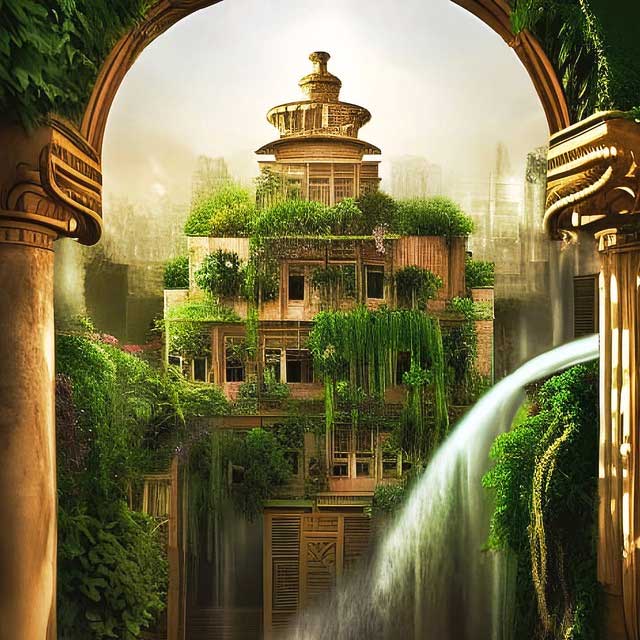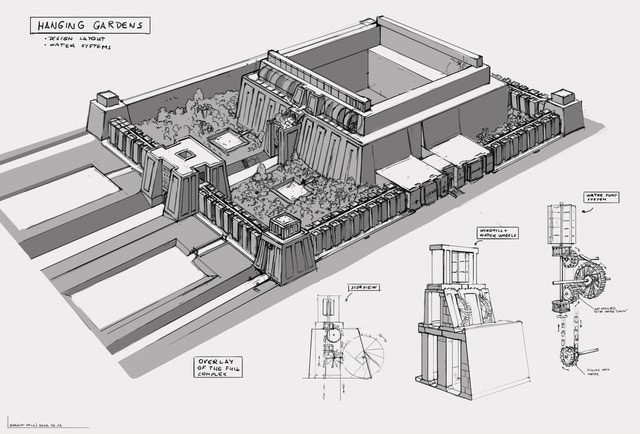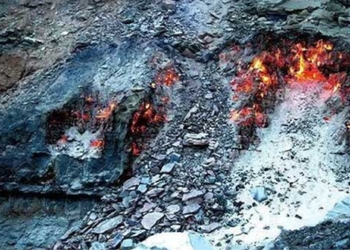The Hanging Gardens of Babylon are one of the seven wonders of the ancient world, always embodying a mysterious beauty but, in reality, concealing a beautiful love story behind them.
According to legend, the Hanging Gardens of Babylon were built by King Nebuchadnezzar II of Babylon for his queen, Amytis. Queen Amytis was a foreign princess who, after marrying Nebuchadnezzar II, longed for her homeland filled with mountains, water, flowers, and grass, as Babylon was surrounded only by endless desert. To comfort her, Nebuchadnezzar II summoned skilled craftsmen from all over to construct a monument in the northern part of Babylon.
The garden covered an area of approximately 120 square meters, with four tiers supported by enormous stone columns, and a variety of flowers and trees were planted throughout. Remarkably, the craftsmen of that era actually created an automated water circulation system that pumped water from the ground and the Euphrates River to great heights for irrigation, also forming streams and waterfalls. Such a spectacular architectural masterpiece left future generations in awe and thus was listed as one of the Seven Wonders of the Ancient World.

The Hanging Gardens of Babylon are a magnificent testament to human ingenuity and ambition. Built by King Nebuchadnezzar II around 600 BC, the gardens are believed to be located near present-day Baghdad, Iraq, and were constructed as a gift for his beloved wife, Queen Amytis.
However, like other ancient wonders, this garden also harbors many mysteries.
First and foremost, its authenticity is a contentious issue. There is no evidence of this garden in ancient documents and records, and descriptions of the garden come only from Greek and Roman writers centuries later, who had never seen it and relied solely on written legends.
Secondly, there are differing opinions regarding the location of this garden. Some say it was within the city of Babylon, while others claim it was outside the city walls; regarding construction materials, some suggest it was made of brick and stone, while others argue it was wood and willows; these contradictions lead people to wonder if the Hanging Gardens of Babylon are merely a fictional story.

It is believed that a complex system of pumps and water wheels was used to irrigate the terraced gardens from the Euphrates River, allowing lush greenery and beautiful flowers to flourish in a barren desert landscape.
Additionally, many archaeologists and historians are searching for remnants and evidence of this garden. They have excavated several sites in the ancient city of Babylon but found no structures or sculptures related to the Hanging Gardens, nor any architectural remains linked to it.
Although remnants such as the Walls of Babylon, the Tower of Babel, and the palace of King Nebuchadnezzar II have been discovered, these ruins have no connection to the Hanging Gardens of Babylon.
Just when people were about to give up, Dr. Stephanie Dalley, a historian at the University of Oxford, proposed an alternative viewpoint: The Hanging Gardens of Babylon were not in Babylon but in Nineveh, the capital of the Assyrian Empire, located 480 kilometers north of Babylon, and the builder of the Hanging Gardens was Sennacherib, the ruthless king of the Assyrian Empire, not Nebuchadnezzar II of Babylon. Several pieces of evidence support this claim:
- Sennacherib once captured Babylon and referred to Nineveh as “the new Babylon.” Later, it was said that the Hanging Gardens of Nineveh were colloquially called the Hanging Gardens of Babylon.
- Nineveh is located near the Tigris River and has ample water resources, making it more suitable for building a hanging garden, while Babylon is situated in the desert and lacks a suitable environment.
- On the walls of the Nineveh palace, there are several bas-reliefs depicting the kings of that time, and some elevated corridors have tall plants resembling hanging gardens, which do not exist in Babylon.
- Dr. Stephanie Dalley discovered a key term in Assyrian literature called “alemit,” meaning “the lifter,” which is a device for pumping water from low to high. Dr. Dalley believes this device is actually the core of the water circulation system of the gardens, and there is no such term in Babylonian literature and language.

Despite numerous efforts, no archaeological evidence has been found to confirm the existence or exact location of the Hanging Gardens of Babylon. This has led some scholars to believe that it may simply be a myth.
In conclusion, Dr. Stephanie Dalley’s perspective is indeed compelling and may explain many doubts about the Hanging Gardens of Babylon, while also aligning with archaeological findings and literature from Nineveh. However, the motivation and story behind constructing such a garden in the Assyrian Empire still require further evidence and research for clarification.
The first mention of the Hanging Gardens was by Berossus, a reputable Babylonian historian who wrote about the gardens around 270 BC. He recounted that King Nebuchadnezzar built a new palace in 15 days, with stone foundations on terraced lands resembling mountainous landscapes.
Later Greek writers added many details. One theory states that the garden covered 120 square meters, with the city walls standing about 25 meters high. The garden featured terraced land like an amphitheater, with smaller structures harmoniously integrated within.
The foundation was constructed with many walls, each about 7 meters wide and spaced 3 meters apart, to support stone beams. Above the beams were three distinct layers—reeds placed in a layer of bitumen, two layers of brick, and an outermost layer made of lead. The soil in the garden was placed on top, with irrigation water drawn from concealed machines that extracted water from the river below.





















































